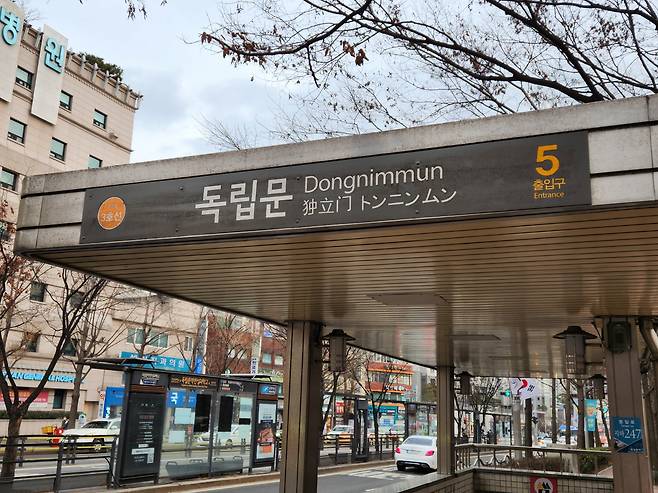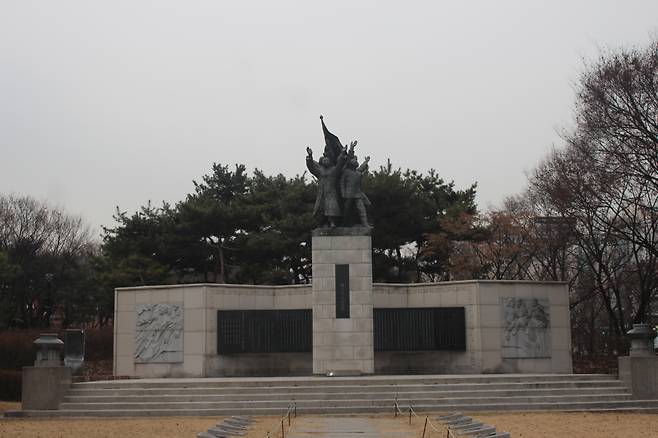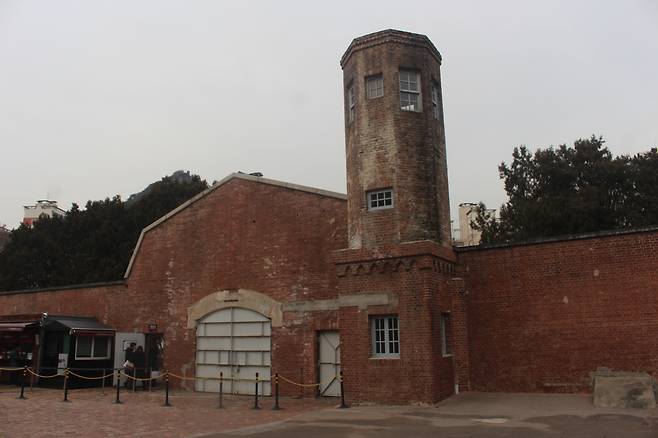[Subway Stories] Dongnimmun Station, where memories of heroes are commemorated
이 글자크기로 변경됩니다.
(예시) 가장 빠른 뉴스가 있고 다양한 정보, 쌍방향 소통이 숨쉬는 다음뉴스를 만나보세요. 다음뉴스는 국내외 주요이슈와 실시간 속보, 문화생활 및 다양한 분야의 뉴스를 입체적으로 전달하고 있습니다.
이 기사는 언론사에 의해 수정되어 본문과 댓글 내용이 다를 수 있습니다.
Almost immediately, one can feel the nationalistic pride that fills Dongnimmun Station as the taegeuk mark and the four black trigrams of the Taegeukgi, the national flag, can be seen across multiple corners of the Line No.3 terminal. It is one of the few subway stations in Seoul that has its own unique design reflecting the significance of the surrounding areas.

Such meaning can be found immediately upon stepping out of exit No. 3, adjacent to a small exhibition hall named “House for the Families of Independence Fighters.” The diminutive museum is a tribute to the independence fighters’ families whose homes were demolished due to urban redevelopment.
The entire area around Dongnimmun Station is in fact one big monument to those who gave their lives fighting Japanese colonizers during the occupation of the Korean Peninsula, between 1910 and 1945.
Standing tall as a symbol of Korean independence is the stone structure called Independence Gate, also known as the Dongnimmun Arch -- the namesake of the station. It was erected in the late 19th century to initially serve as a monument for Korea’s independence from the Chinese Qing Dynasty.
The arch is part of the Seodaemun Independence Park, which opened in 1992 to commemorate the Koreans who fought for the nation’s freedom from Japan. It is across the street from exits No.1 through No.3, and is directly accessible via exit No. 5, with exit No. 4 currently under construction.
The 10,000-square-meter park was redesigned in 2008 as an urban park, with plenty of plant life, a trail and ponds, along with monuments and statues of national heroes. Near by Independence Gate are the visitors’ center, the maintenance office, the information center and a patrol station operated by the Seodaemun Police Station.

Heroes remembered
Near the gate of the Seodaemun Independence Park stands a statue of Soh Jai-pil, one of the founders of The Independent, or Dongnip Sinmun, the first modern daily newspaper in Korea which ran from 1896 to 1899. Also known as Philip Jaisohn, this man is also the person who proposed and planned the construction of the Independence Gate.

Not far from Soh’s statue is a memorial dedicated to the March 1st Independence Movement of 1919, a large-scale civil protest by Koreans across the nation that protested Japanese rule and declared the independence of the nation. Up front is a statue symbolizing those who participated in the movement, behind which there is a monument dedicated to the Korean Declaration of Independence and the 33 people who led the uprising.
Ryu Gwan-sun, one of the most well-known names in the March 1 movement, is honored with a statue in the middle of the park. Inscribed on the foundation is some brief information about her life, along with what was known as her final words: “I could bear the pain of losing my fingernails, my ears and nose being cut off and my hands and legs being broken, but I cannot bear the pain of losing my country. It is my only regret that I have but one life to give for my country.”


The freedom fighter was tortured and died of an unspecified cause in the infamous Seodaemun Prison, built in 1908 by Japan. By this time, the Japanese Empire had mostly gained control of the Korean Empire and was preparing the formal annexation of the peninsula.

After opening as Gyeongseong Jail, it went through several name changes before ceasing function as a prison and becoming Seodaemun Prison History Hall in 1987.
The significance of the venue is in its near-perfect preservation, or restoration, of the jail cells that, during its 80 years of use, held numerous independence fighters, as well as pro-democracy activists during the dictatorial regime in the later part of the 20th century. The cold, narrow halls and minute cells offer a hint at the ruthlessness of the Japanese colonizers and the military juntas of South Korea which locked up those who opposed them here.


The exhibition hall is open between 9:30 a.m. and 6 p.m. from March to October, and 9:30 a.m. to 5 p.m. from November to February. It closes on Jan. 1, Seollal and Chuseok holidays, as well as every Monday. Entrance fees are 3,000 won ($2.45) for adults, 1,500 won for juveniles (ages 13-18), 1,000 won for children and 1,500 won for active members of the military.
Those aged 65 or above and those aged six or less can enter free of charge. Also exempt from the fee are those who have been deemed “persons of distinguished service to the state” by the government.
For more information about the Seodaeumen Prison History Hall, including information about the free docent programs and reservations, visit its website at https://sphh.sscmc.or.kr, which is available in Korean, English, Chinese and Japanese.
By Yoon Min-sik(minsikyoon@heraldcorp.com)
Copyright © 코리아헤럴드. 무단전재 및 재배포 금지.